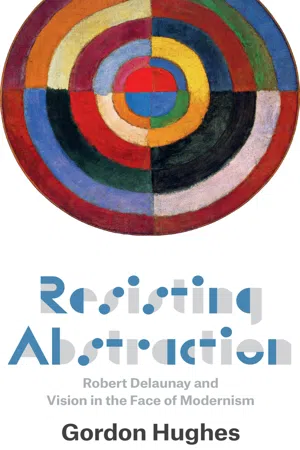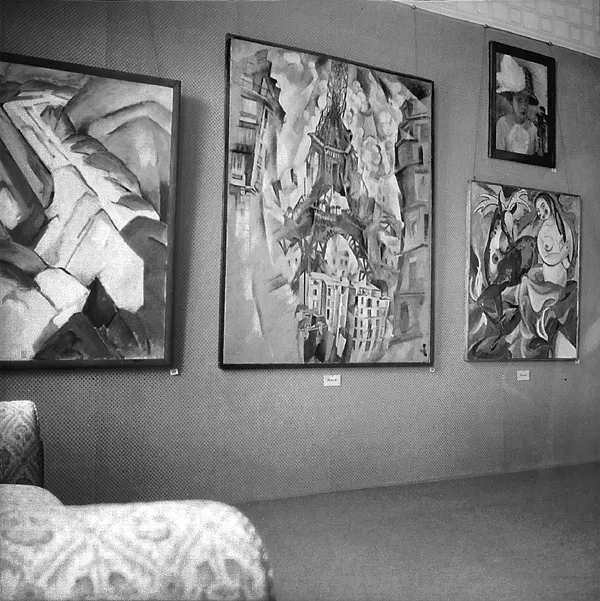
- English
- ePUB (mobile friendly)
- Available on iOS & Android
eBook - ePub
About this book
Robert Delaunay was one of the leading artists working in Paris in the early decades of the twentieth century, and his paintings have been admired ever since as among the earliest purely abstract works.
With Resisting Abstraction, the first English-language study of Delaunay in more than thirty years, Gordon Hughes mounts a powerful argument that Delaunay was not only one of the earliest artists to tackle abstraction, but the only artist to present his abstraction as a response to new scientific theories of vision. The colorful, optically driven canvases that Delaunay produced, Hughes shows, set him apart from the more ethereal abstraction of contemporaries like Kandinsky, Mondrian, Kazimir Malevich, and František Kupka. In fact, Delaunay emphatically rejected the spiritual motivations and idealism of that group, rooting his work instead in contemporary science and optics. Thus he set the stage not only for the modern artists who would follow, but for the critics who celebrated them as well.
With Resisting Abstraction, the first English-language study of Delaunay in more than thirty years, Gordon Hughes mounts a powerful argument that Delaunay was not only one of the earliest artists to tackle abstraction, but the only artist to present his abstraction as a response to new scientific theories of vision. The colorful, optically driven canvases that Delaunay produced, Hughes shows, set him apart from the more ethereal abstraction of contemporaries like Kandinsky, Mondrian, Kazimir Malevich, and František Kupka. In fact, Delaunay emphatically rejected the spiritual motivations and idealism of that group, rooting his work instead in contemporary science and optics. Thus he set the stage not only for the modern artists who would follow, but for the critics who celebrated them as well.
Frequently asked questions
Yes, you can cancel anytime from the Subscription tab in your account settings on the Perlego website. Your subscription will stay active until the end of your current billing period. Learn how to cancel your subscription.
No, books cannot be downloaded as external files, such as PDFs, for use outside of Perlego. However, you can download books within the Perlego app for offline reading on mobile or tablet. Learn more here.
Perlego offers two plans: Essential and Complete
- Essential is ideal for learners and professionals who enjoy exploring a wide range of subjects. Access the Essential Library with 800,000+ trusted titles and best-sellers across business, personal growth, and the humanities. Includes unlimited reading time and Standard Read Aloud voice.
- Complete: Perfect for advanced learners and researchers needing full, unrestricted access. Unlock 1.4M+ books across hundreds of subjects, including academic and specialized titles. The Complete Plan also includes advanced features like Premium Read Aloud and Research Assistant.
We are an online textbook subscription service, where you can get access to an entire online library for less than the price of a single book per month. With over 1 million books across 1000+ topics, we’ve got you covered! Learn more here.
Look out for the read-aloud symbol on your next book to see if you can listen to it. The read-aloud tool reads text aloud for you, highlighting the text as it is being read. You can pause it, speed it up and slow it down. Learn more here.
Yes! You can use the Perlego app on both iOS or Android devices to read anytime, anywhere — even offline. Perfect for commutes or when you’re on the go.
Please note we cannot support devices running on iOS 13 and Android 7 or earlier. Learn more about using the app.
Please note we cannot support devices running on iOS 13 and Android 7 or earlier. Learn more about using the app.
Yes, you can access Resisting Abstraction by Gordon Hughes in PDF and/or ePUB format, as well as other popular books in Art & Art General. We have over one million books available in our catalogue for you to explore.
Information


1.1. Robert Delaunay, Portrait of Henry Carlier, 1906. Oil on canvas, 64 cm × 60 cm. Musée National d’Art Moderne, Centre Georges Pompidou, Paris (AM2592P). Photo: Jean-Claude Planchet. CNAC/MNAM/Dist. Réunion des Musées Nationaux/Art Resource, NY.

1.2. Robert Delaunay, Landscape with Sun (verso of self-portrait), 1905–1906. Oil on canvas, 54 cm × 46 cm. Musée National d’Art Moderne, Centre Georges Pompidou, Paris (AM4074Precto). Photo: Jacqueline Hyde. CNAC/MNAM/Dist. Réunion des Musées Nationaux/Art Resource, NY.

1.3. Robert Delaunay, Saint Séverin No. 1, 1909. Private collection. Photo: Gianni Dagli Orti. Art Archive/Art Resource, NY.
Delaunay contra Cubism
The year 1912 was a watershed for Robert Delaunay. On March 13 his first major exhibition in Paris closed to favorable reviews after two weeks at the Galerie Barbazanges.1 Comprising forty-six works, the exhibition spanned his career to date, featuring his early, self-taught impressionist works (figure 1.1), his 1905–1906 neoimpressionist period (figure 1.2), a single painting from his 1909–1910 Saint-Sévrin series (Saint-Sévrin No. 1) (figure 1.3), a large number of Parisian cityscapes produced between 1909 and 1911 (figure 1.4), and the series of cubist Eiffel Tower paintings from 1909–1911 (figure 1.5). The poet and critic Guillaume Apollinaire, who was to live briefly with Delaunay and his wife, Sonia, from November to mid-December of 1912, praised these works in his review of the exhibition, trumpeting Delaunay as “an artist who has a monumental vision of the world. . . . Robert Delaunay has already come to occupy an important place among the artists of his generation.”2 Two weeks later, Apollinaire singled out La ville de Paris (figure 1.6) in his review of the Salon des Indépendants. “Decidedly, the picture by Robert Delaunay is the most important of this salon,” he effused. “La ville de Paris is more than an artistic manifestation. . . . He sums up, without any pomp, the entire effort of modern painting.”3 The critic Roger Allard agreed, deeming the “colored symphony” of La ville de Paris “the most remarkable” contribution on display.4

1.4. Robert Delaunay, La Ville No. 2, 1910. Oil on canvas, 146 × 114 cm. Musée National d’Art Moderne, Centre Georges Pompidou, Paris (AM2766P). Photo: Philippe Migeat. CNAC/MNAM/Dist. RMN-Grand Palais/Art Resource, NY.

1.5. Robert Delaunay, Champs de Mars: The Red Tower, 1911/1923. Oil on canvas, 160.7 × 128.6 cm. Art Institute of Chicago, Joseph Winterbotham Collection (1959.1). Photograph © The Art Institute of Chicago.
Flagged by Apollinaire and other influential critics as a new force on the Parisian artistic landscape, Delaunay was also making steady strides elsewhere in Europe, particularly in Germany. He participated in the first Blaue Reiter exhibition in Munich (figures 1.7–1.9), where he sold four of the five works on view, including the first La ville, now lost, to the painter Alexei von Jawlensky.5 More important than sales, however, was the enthusiasm for Delaunay’s painting that abounded among members of the Blaue Reiter, leading to active correspondence between Delaunay and Wassily Kandinsky, August Macke, and Franz Marc.6 Delaunay’s Blaue Reiter connections also resulted in Erwin Ritter von Busse’s article “Robert Delaunay’s Methods of Composition,” which appeared in the 1912 Blaue Reiter Almanac, alongside Roger Allard’s essay “The Signs of Renewal in Painting,” which praised Delaunay as a painter “who has conquered the arabesques of the picture plane and who shows the rhythm of great, indefinite depths.”7 Delaunay went on to exhibit that February in the second Blaue Reiter exhibition in Munich and in the Valet de carreau exhibition in Moscow. At Kandinsky’s urging he also participated in the inaugural Der Sturm exhibition in Berlin, which opened March 12, 1913,8 and through Hans Arp, at the Moderner Bund zweite Ausstellung in Zurich that July. As Delaunay’s reputation spread, Paul Klee was among the many painters outside of France to feel his influence. Klee visited him at his Paris studio in 1912, and his German translation of Delaunay’s 1912 essay “La lumière” (“Light”) appeared in the January 1913 issue of Der Sturm as “Über das licht.”9

1.6. Robert Delaunay, The City of Paris (Ville de Paris), 1910–1912. Oil on canvas, 267 × 406 cm. Musée National d’Art Moderne, Centre Georges Pompidou, Paris (AM2493P). Photo: Jean-Claude Planchet. CNAC/MNAM/Dist. Réunion des Musées Nationaux/Art Resource, NY.

1.7. Robert Delaunay, Saint-Séverin (left of the doorway), in the first Blaue Reiter exhibition, room 2, December 19, 1911–January 1, 1912. Gabriele Münter- und Johannes Eichner Stiftung.

1.8. Robert Delaunay, The Eiffel Tower (middle), in the first Blaue Reiter exhibition, room 3, December 19, 1911–January 1, 1912. Gabriele Münter- und Johannes Eichner Stiftung.

1.9. Robert Delaunay, The City (No. 1) (left) in the first Blaue Reiter exhibition, room 1, December 19, 1911–January 1, 1912. Gabriele Münter- und Johannes Eichner Stiftung.
By the beginning of 1913 Delaunay was firmly ensconced within the upper ranks of the international avant-garde. In January he and Apollinaire traveled to Berlin to participate in the twelfth Der Sturm exhibition, Ständige Ausstellungen der Zeitschrift der Sturm, zwölfte Ausstellung, which ran from January 27 to February 20. Alongside works by Ardengo Soffici and Julie Baum, Delaunay exhibited twenty-one works in total (nineteen listed in the catalog plus two late additions), offering the first glimpse of his postcubist production to a German audience, including a dozen or so of the Window series and a sketch for the first The Cardiff Team. Nine days before the official opening, Apollinaire gave a lecture titled “Die neue Malerei” (“Modern Painting”), in which he championed Delaunay and Picasso as representing the two “most important” new tendencies in modernist painting.10 A month later, Herwarth Walden published Apollinaire’s lecture in the same issue of Der Sturm as Paul Bommersheim’s “Der Uberwindung der Perspektive und Robert Delaunay” (“The Overcoming of Perspective and Robert Delaunay”).11 Walden also helped Delaunay publish a catalog of the complete Window series, prefaced by Apollinaire’s poem “Les fenêtres.”12
Despite his burgeoning reputation in Europe, the organizers of the 1913 Armory Show in New York rejected Delaunay’s La ville de Paris, claiming the painting’s imposing size (an impressive 267 by 406 centimeters) would overwhelm the other works in the exhibition. Incensed, Delaunay tried unsuccessfully to remove his other contributions in protest.13 The organizers of Budapest, müvészház: Nemzetközi postimpresszionista kiallitas, a postimpressionist exhibition in Budapest arranged in collaboration with Walden, had no such qualms, exhibiting the canvas later that March along with eighteen other paintings by Delaunay. From Budapest it was on to Florence, where, from the end of May to the end of June, he exhibited three paintings in at the Società delle belle arti. In August 1913 he participated in another major exhibition of modernist work at the gallery Hans Goltz in Munich, the same month that his drawing Eiffel Tower was featured on the cover of Der Sturm.
For all of Delaunay’s mounting influence and tireless exhibiting in the years 1912–1913, his legacy would have amounted to little more than an art-historical footnote were it not for his great breakthrough, his 1912 Window series (figures 1.10–1.25). Begun in La Madeleine in the Chevreuse Valley, where the Delaunays were vacationing for the summer, the twenty-two-painting series marks the moment of Delaunay’s artistic maturity following his break with cubism. The Windows, he writes, “truly began my life as an artist.”14 It was this series of remarkable paintings—unabashed, flaunting even, in their use of color—that ended Delaunay’s otherwise relatively unremarkable apprenticeship within cubism. Evidence to all who saw them that Delaunay had broken ranks, the Window series quickly established his reputation as “l’hérésiarque du cubisme”—“the heretic of Cubism.”15
To reference Delaunay’s self-proclaimed heresy or to characterize him as “breaking ranks” is not, I should make clear, to ascribe an overall aesthetic or conceptual cohe...
Table of contents
- Cover
- Copyright
- Title Page
- Dedication
- Contents
- Introduction
- 1. Break (Windows)
- 2. Punch (Painting)
- 3. Movement (into Abstraction)
- Conclusion
- Acknowledgments
- Notes
- Index